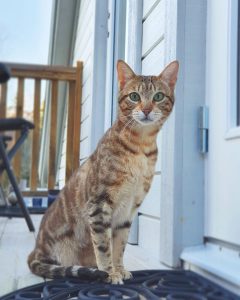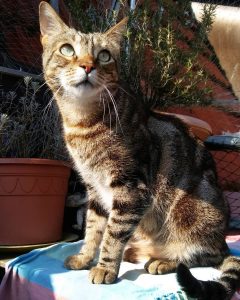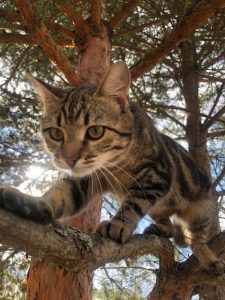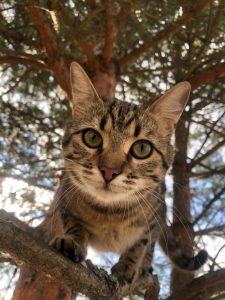The Sokoke (Kenyan Forest Cat) is one of the 50 rarest breeds in the world. In 1992, these animals were found in Kenya and standardized in England.
The story of this kitten begins in the 70s when English breeders traveled to a region in western Kenya called Sokoke. Here they found a peculiar kitten, with beautiful fur resembling the bark of a tree, and who lived in urban areas and many rural areas. Impressed by the beauty of these animals, the breeders adopted two kittens and brought them to Europe, where they began their breeding program to adapt this striking breed to family life as a new breed of feline pets. Soon the breed became well known and famous, as it had good recognition.

Looking at the Sokoke cat, you see a very bright individual, medium in size, and with an elongated body and developed muscles, which makes it an excellent climber. The animal’s green or amber eyes are paired with brown fur, which is painted with a variety of dark lines and patterns. Such a good camouflage is very helpful in the wild. The short fur is soft and thick, always bright, which indicates good health.
Absolutely everything in this animal attracts attention: huge eyes, unusual coat color, curious and cheerful disposition.
The aborigines nicknamed the animal “Hadzonzo”, which means “similar to the bark of a tree.” But the truth is, the pet’s fur pleases the eye in shades from pale cream to dark brown. And the arrangement of the colored stripes on the TV sets makes it look like a wild tigress.
Affectionate and playful Sokoke cat with high endurance and excellent health.
Sokoke (Soukok, Kenyan Forest) is one of the rarest cat breeds in the world originally from Kenya with a rather muscular but graceful torso. The cat has an average size and weight in the range of 3-5 kg.

The chiseled, athletic torso and fast movement give the animal a cheetah-like appearance.
The limbs of the animal are quite long, and the hind legs are much longer than the front ones, which gives the Sokoke a special gait and allows significant jumps in height and length. The limbs are moderately strong and the feet are compact with dark pads.
The cat’s tail is of medium length and thickness, and its tip is slightly rounded.
The head is small, wedge-shaped, triangular in shape, and the neck is short, muscular, and rather broad.
Sokoke’s ears are rather large, high set and wide-set, have tassels at the tips, and are slightly pointed. The set of ears in the standard is described as straight and if a bird or some kind of fly runs, all attention will only be forward.
The cat’s muzzle is small and wedge-shaped. The nose is of medium length and the cheekbones are high.
Representatives of this breed have large, almond-shaped eyes with a wide set and slightly slanting. The look is deep and penetrating, and the color of the eyes should be gold or green.
The coat of pets of the Sokoke cat breed is short, elastic, and silky, there is no undercoat.
The Sokoke color, according to the ideal exterior standard, is a marble tabby with pronounced rosettes. Ticking in a cat gives the impression of dustiness or mottling, which in natural conditions allows Sokoke to successfully camouflage itself among the thickets.

The main character traits of Sokoke are unpretentiousness, conflict-freeness, and self-esteem. As a rule, they are quite restrained in the manifestation of feelings and share their affection approximately equally among all family members, without clearly distinguishing anyone. Representatives of this breed of cats are sociable and cheerful.
You might think that in domestic life, the nature of pets should be stubborn, because it was adapted from the wild, and although there are rather closed specimens, the vast majority of Sokoke cats are friendly, affectionate, sociable and playful animals that can live with everyone family members without problems. They are attached to their masters and quite empathetic – it seems that their special sensitivity allows them to feel the humor and emotions of people. They demand attention for their affection, and since they have tremendous energy, they enjoy playing, especially outdoors.
Sokoke care is pretty simple. The natural origin of cats makes itself felt, so they take care of themselves quite tolerably well on their own. All you need to do is brush your cat periodically (about once a week and a half) and occasionally bathe it. Regular monitoring of the ears, teeth, and gums of the animal, as well as periodic preventive examinations by the veterinarian, is mandatory.
The health of the representatives of this breed is excellent. However, according to some reports, Sokoke is prone to nervous disorders in some cases.
It should be borne in mind that the subcutaneous fat layer is poorly developed in a cat, therefore, it should be protected from low temperatures. Sensitivity to cold makes them susceptible to colds.
Food for Sokoke should be balanced, with a predominance of proteins. Many of them like to snack on fruits or vegetables. With proper organization of feeding, a cat will live up to 15 years.
The Sokoke is very active and requires a lot of space to play. A cat of this breed is perfect for those people who spend a lot of time outside the home. It would also be reasonable to keep it in the private sector since the sokoké retained their hunting qualities. They can get along with other members of the animal world if they already live with the owner in the same territory.

Cats of this breed are very smart, cunning, and calculating. They will be happy to carry out your commands, as long as you do not humiliate their dignity. Another difference between them is that it is quite difficult to deceive representatives of this breed. Sokoke swims well and climbs trees well. Sometimes this Sokoke cat breed is called Soukok.
Sokokе is good for homes with older children or for dog owners as they are a very sociable breed.
However, owners say their endless energy means they probably won’t be suitable for older owners or those with small children.
“They are very lively and much more playful than sedate! Some of mine went to homes with kids six or seven years old because they love exercise and fun, so they’ll have fun playing with the kids for hours, ”she says.
Sokokes is happy at home during the day while you are at work, but he will get bored if left alone, so he will definitely need company, be it another cat or human, and lots of stimulation.
